DENTISTRY
DISEASE
CANAL
REMOVAL
GUARD
EMERGENCY
SUPPORTING YOUR DENTAL EMERGENCY HEALTH
Dental For The Family
Family Dentistry Support
Our Goal is to improve your well being and give you and your family a comfortable and enjoyable dental experience. At Dental Arts of Huntley, we provide comprehensive oral health care to people of all age group. Your first visit with us, Dr.Bansal will guide you towards better oral health after performing
- Comprehensive intra oral and extra oral checkup
- Full mouth X rays/radiographs
- Cleaning and polishing
- Fluoride treatment
Emergency Dental Explained
Dental Emergency
Dental emergencies happen all the time. At Avon Dental in Round Lake we make it convenient for you to see a dentist as quickly as possible. If you are experiencing a dental emergency, including but not limit to:
- A bitten lip or tongue
- Broken or cracked tooth/teeth
- Broken jaw
- Permanent tooth that has been knocked out
- Object caught between teeth
- Severe toothache
Please give us a call. If this is an after hours call, please leave a message and one of our staff members will get back to you first thing in the morning. We are here to help you, any time, any day, and when your dental health is at risk, we’ll do everything we can to make sure that you’re treated as soon as possible. While dental emergencies are rare, they can happen, and it’s important to know how to take care of your teeth no matter what.
A knocked-out tooth is a dental emergency that requires urgent attention. If the appropriate emergency steps are followed immediately after the tooth has been knocked out, the chances are very good that the tooth can be reinserted and preserved by a dentist.
- Pick up the tooth by the top (crown) of the tooth. Do not touch the root(s) of the tooth.
- Rinse the tooth off very gently to ensure that it’s clean. Do not scrub the tooth or remove any tissue attached to it. Be sure to place a towel or washcloth in the sink so that the tooth does not go down the drain.
- If you can, gently place the tooth back into the socket. Hold it gently in place while trying to bite down.
- If you can’t place the tooth back in the socket, put the tooth in a small container or in a cup of milk. Note that the latter is preferable.
- Call your dentist immediately, since getting to the dentist quickly with your tooth – in addition to following the steps above – is critical for saving the knocked-out tooth. The longer you wait to re-implant the tooth in its socket, the less chance you have of the tooth “taking” and remaining viable.
Loose Tooth, Tooth Out of Alignment
If you have a tooth that is loose or out of alignment, you should call your dentist for an emergency appointment right away. In the meantime, you can try to put the tooth back in its original position using your finger with very light pressure. Do not try and force it. You can bite down to keep the tooth from moving. Your dentist may want to splint the tooth to the adjacent teeth (the teeth on each side) to keep it stabilized.
Chipped, Cracked or Fractured Teeth
If a tooth is chipped and doesn’t hurt, this usually does not constitute a dental emergency and you can wait a few days to see a dentist. However, it is important to be careful while chewing so as not to chip it more. Your dentist may simply be able to smooth the chip out, or add some composite filling material to repair the tooth.
A cracked or fractured tooth is a serious issue constituting a dental emergency. Fractured or cracked teeth usually suggest that damage has occurred to the inside of the tooth as well as to the outside. Severe fractures are so extreme that the tooth cannot be saved. If you suffer a fractured tooth, call your dentist immediately for an emergency appointment and follow these steps:
- Clean your mouth out by gently rinsing thoroughly with warm water.
- If the fracture is caused by facial trauma, apply a cold compress to the area to minimize any swelling.
- Take acetaminophen (not aspirin) according to the packaging directions to alleviate pain.
- Never apply a painkiller to the gum because it can burn the gum tissue. This includes Orajel, which often is marketed for these types of procedures.
An X-ray will be needed in order for your dentist to properly diagnose the condition of your tooth. If the soft tissue inside of the tooth (the tooth pulp) is damaged, your tooth may need a root canal. If the pulp is not damaged, the tooth might only need a crown.
Some dentists make some of their permanent crowns in-office and place them in the same day; other dentists use an outside laboratory to make the crown. In this case you will have to wear a temporary crown while the laboratory makes a permanent crown. If the tooth cannot be saved, your dentist will inform you of the various alternatives for replacing missing teeth, such as implant-supported restorations and bridges.
Tissue Injury and Facial Pain
Any type of injury inside the mouth, such as puncture wounds, lacerations and tears to the lips, cheeks, mouth and tongue, are considered tissue injuries and a dental emergency. If you experience any type of tissue injury, it is important to clean the area immediately with warm water. If the bleeding is coming from the tongue, gently pull the tongue forward and place pressure on the wound using gauze. You should get to an oral surgeon or nearby hospital emergency room as quickly as possible.
To alleviate any type of facial pain associated with tissue injury, you can take acetaminophen as directed on the packaging label. Never take aspirin or ibuprofen for a dental emergency because they are anticoagulants, which can cause excessive bleeding.
Other Dental Emergencies
Basically, any dental problem that requires immediate treatment in order to save a tooth, stop ongoing tissue bleeding or alleviate severe pain is considered a dental emergency.
A severe infection or abscess in the mouth can be life-threatening and should be dealt with immediately. Your dentist might be able to perform the first stage of a root canal, or will refer you to an endodontist (root canal specialist) to open and drain the tooth and allow the abscess to drain. If your dentist can’t be reached, seek hospital emergency room care.
Problems with Temporary Restorations
Having a temporary dental crown come off is not a dental emergency. However, it is important to put it back in place so that the tooth stays in its original position until you can see your dentist.
A temporary crown can easily be put back onto your tooth by placing Vaseline, toothpaste, Chapstick or even a very small amount of denture adhesive into the temporary and placing it onto your tooth. Try putting your crown in first and note how it fits into place. Once you are comfortable with the fit, apply adhesive into the temporary and place it properly on your tooth. Bite down firmly onto a dry washcloth, applying even pressure to the temporary. After a few minutes, clean off any excess adhesive you can see. You should see your dentist within the next few days to have it properly re-cemented.
Is it a Dental Emergency?
Smoothing a chipped tooth, re-cementing a crown that is not causing pain and composite bonding to repair a tooth are not dental emergencies. Typically, such problems can be dealt with during your dentist’s regular office hours.
If you are not sure whether or not you are having a true dental emergency, answer the following questions:
- Are you bleeding from the mouth?
- Are you in severe pain?
- Do you have any loose teeth?
- Have you been hit in the face or mouth?
- Do you have any swelling in the mouth or facial area?
- Do you have any bulges, swelling or knots on your gums?
If you answered yes to any of these questions, you might be having a dental emergency and should call your dentist immediately. It’s important to describe to your dentist exactly what has happened and what you are feeling.
If you experience extreme pain caused by hot or warm foods or beverages, try drinking ice water. It might relieve the pain. Sip on ice water and hold some in your mouth until you see the dentist.
If you are having sensitivity to cold or if it causes pain to breathe in air, avoid cold foods and beverages. Breathe through your nose and call your dentist’s office.
If you experience pain in a tooth when biting down, it might indicate an abscess. This is an emergency and you should call your dentist’s office.
How to Avoid a Dental Emergency
Many dental emergencies can be easily avoided by having routine check ups with your dentist to ensure that your mouth and teeth are healthy, strong and free from decay.
Wearing a mouth guard during sports activities will help to prevent teeth from being chipped, knocked out or broken. Avoid chewing on ice and hard foods that may break or fracture your teeth. If you are planning to travel out of the country or leaving for an extended vacation, during which you may not have ready access to dental care, it is important to see your dentist for a routine check up before you leave. Your dentist can make sure that you don’t have any loose crowns or teeth, decay close to the nerve of a tooth that could cause you pain or develop into an abscess or other problems that could be easily fixed before becoming a dental emergency later.
For more information about safe care in the event of a dental emergency while traveling, contact the Organization for Safety and Asepsis Procedures (OSAP), or theInternational Association for Medical Assistance to Travelers (IAMAT).
Being Prepared for a Dental Emergency
Because a dental emergency can happen at any time and place, the best thing to do is be prepared and don’t panic. Pack and keep with you a small dental first aid kit containing the following:
- Small container with a lid
- Name and phone number of your dentist
- Acetaminophen (not aspirin or ibuprofen because they can act as a blood thinner and cause excessive bleeding during a dental emergency).
- Gauze
- Handkerchief

family friendly kids dentistry

Child Dentistry
Start your Children’s Dental Visits Early
Parents frequently ask us when they should first bring their young children to the dentist. Dr.Bansal recommend the first visit for children’s dentistry be around the age one. It is vital that children start their early dental experiences with fun, easy, non-threatening visits. Our dental hygienists and doctor are great with the little ones. Children learn about the suction (“Mister Thirsty”), the water squirter, the bright light that they get glasses for, and if they are ready for it, the tickling toothbrush.
Sealants?
Sealants are thin, protective coatings made of a special type of plastic painted on the chewing surfaces of your teeth. They work to seal off the grooves and pits on your teeth where bacteria collect.
Sealants prevent the most cavities when applied soon after permanent molars come into the mouth (around age 6 for 1st molars and age 12 for 2nd molars). Will it hurt to get a sealant? Getting a sealant is easy and does not hurt. The tooth is cleaned and a gel may be placed on the chewing surface for a few seconds.
Treating Cavities With Sealants
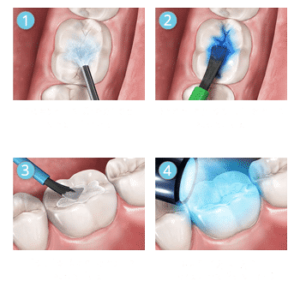
Clean / etch / sealing / curing
Step 1: Clean
Cleaning the tooth is essential for proper sealant. This ensure that the bacteria is totally been eliminated before sealant is applied. Sealants are a quick, easy, and painless way to prevent cavities. A tooth without a cavity is stronger and healthier than a tooth with a filling or untreated decay. Sealants are also less expensive and easier to apply than fillings.
Step 2: Prep/Etch
Etching doesn’t hurt. It’s a process of scrapping the tooth or teeth in order to roughen the teeth slightly. This prepares the suffice for the seal coat by making the tooth porous as to accept the sealant coating.
Step 3: Seal
Sealants have shown to still work 9 years after placement. However, sometimes they do fall off, so they should be checked at regular dental appointments. If a tooth loses a sealant, the protective shield is gone and the tooth can get a cavity. Missing sealants are easy to replace.
Step 4: Cure
Sealants are one part of a child’s total preventive dental care. Visit CDC’s Children’s Oral Health for additional ways to prevent cavities. Once cured, sealants protect against 80% of cavities for 2 years and continue to protect against 50% of cavities for up to 4 years.
How To Protect Your Teeth
Caring For Your Teeth
What is Fluoride?
Fluoride is a mineral that occurs naturally in oceans, rivers, and streams. It works to help replace lost phosphorus and calcium in the enamel layer of your teeth (remineralization).
Your teeth are constantly going through a cycle of demineralization and remineralization that weaken and strengthen the hard layer of protective enamel. Exposure to acidic elements like soda, citrus fruits, stomach acids, and certain infections are just a few factors that can increase the acidity of your mouth and weaken your enamel (demineralization).
For many children, women, and men, fluoride treatments or medical-grade fluoride products are a great way to enhance dental health. Integrated into a solid dental hygiene routine, fluoride treatments can strengthen your teeth and protect against decay.
Benefits of fluoride

Treating Calculus / caries / gingivitis
Got Fluoride?
There are numerous ways to get fluoride either topically or systemically, including:
- Municipal water supply (not all areas add fluoride to the water)
- Toothpaste
- Mouthwashes or gels
- Some dental floss
- Certain foods
Some Statistics
Statistics show that communities, where fluoride is added to the water supply, have 20% to 40% lower rates of tooth decay than those where supplementation is not available. Children in those communities seem to show the most significant improvements in dental health.
Evaluation
Your dentist can evaluate your teeth and overall health to determine if fluoride treatments are right for you. Too much fluoride can cause problems, so getting the right amount is important. We know how to identify your condition and make the clinical recommendation for treatment.
Treatments Vary
Treatments of low to middle medical-grade fluoride products are a great way to enhance dental health.
The fluoride may be in the form of a gel, rinse, foam, or varnish.

What Is Fluoride?
Fluoride is a mineral that occurs naturally in oceans, rivers, and streams. It works to help replace lost phosphorus and calcium in the enamel layer of your teeth (remineralization).
Your teeth are constantly going through a cycle of demineralization and remineralization that weaken and strengthen the hard layer of protective enamel. Exposure to acidic elements like soda, citrus fruits, stomach acids, and certain infections are just a few factors that can increase the acidity of your mouth and weaken your enamel (demineralization).
For many children, women, and men, fluoride treatments or medical-grade fluoride products are a great way to enhance dental health. Integrated into a solid dental hygiene routine, fluoride treatments can strengthen your teeth and protect against decay.
Got Fluoride?
There are numerous ways to get fluoride either topically or systemically, including:
- Municipal water supply (not all areas add fluoride to the water)
- Toothpaste
- Mouthwashes or gels
- Some dental floss
- Certain foods
Some Statistics
Statistics show that communities, where fluoride is added to the water supply, have 20% to 40% lower rates of tooth decay than those where supplementation is not available. Children in those communities seem to show the most significant improvements in dental health.
Evaluation
Your dentist can evaluate your teeth and overall health to determine if fluoride treatments are right for you. Too much fluoride can cause problems, so getting the right amount is important. We know how to identify your condition and make the clinical recommendation for treatment.
Treatments Vary
Treatments of low to middle medical-grade fluoride products are a great way to enhance dental health.
The fluoride may be in the form of a gel, rinse, foam, or varnish.
Bleeding / Infection / Solutions
Gum disease
Gum Disease Treatment Options
One of the most important reasons to keep up with your oral health and continue good hygiene habits is to prevent your mouth from becoming infected with gum disease. However, nearly 75 percent of American adults are affected by this progressive condition due to lack of knowledge, fear of the dentist or improp er home care. Our goal is to catch and perform gum disease treatment before it spreads or develops into advanced periodontitis, an incurable condition that can cause tissue and tooth loss.
Gum Disease Diagnostics and Treatment

Treatment Options are varied and depend on the severity of your case
Scaling and Roots Planing
The first option for gum disease treatment, our doctors will use ultra-small tools to access the area below the gumline. We can then scrape away plaque, tartar and bacteria buildup that is gathering around the tooth roots.
Laser Therapy
A minimally invasive form of gum disease treatment, laser therapy uses gentle laser light to disintegrate disease while leaving healthy tissue unharmed. Many patients prefer this method because there is no cutting or sutures involved and the procedure can often be performed quickly.
Arrestin
This is an antibiotic gum disease treatment that is added to the gum pockets to reduce how deep they are, which minimizes the location for bacteria to thrive. Commonly, Arestin is used in conjunction with scaling and root planing and periodontal maintenance gum disease treatments.
Periodontal Maintenance
Periodontal Maintenance – After gum disease treatment has cleansed the mouth of disease, many patients require follow-up care to ensure the disease does not return. Periodontal maintenance involves scaling and root planing treatment as well as a thorough cleaning of your teeth and gums. We recommend periodontal maintenance occur every three months for optimal results.

Gum Disease Treatment
One of the most important reasons to keep up with your oral health and continue good hygiene habits is to prevent your mouth from becoming infected with gum disease. However, nearly 75 percent of American adults are affected by this progressive condition due to lack of knowledge, fear of the dentist or improp er home care. Our goal is to catch and perform gum disease treatment before it spreads or develops into advanced periodontitis, an incurable condition that can cause tissue and tooth loss.
Scaling and Roots Planing
The first option for gum disease treatment, our doctors will use ultra-small tools to access the area below the gumline. We can then scrape away plaque, tartar and bacteria buildup that is gathering around the tooth roots.
Laser Therapy
A minimally invasive form of gum disease treatment, laser therapy uses gentle laser light to disintegrate disease while leaving healthy tissue unharmed. Many patients prefer this method because there is no cutting or sutures involved and the procedure can often be performed quickly.
Arrestin
This is an antibiotic gum disease treatment that is added to the gum pockets to reduce how deep they are, which minimizes the location for bacteria to thrive. Commonly, Arestin is used in conjunction with scaling and root planing and periodontal maintenance gum disease treatments.
Periodontal Maintenance
A minimally invasive form of gum disease treatment, laser therapy uses gentle laser light to disintegrate disease while leaving healthy tissue unharmed. Many patients prefer this method because there is no cutting or sutures involved and the procedure can often be performed quickly.
Infection / Pain / Comfort
Root Canal
What is a Root Canal?
A “root canal” is a term used to describe the natural cavity in the center of a tooth. This area contains a soft area known as the pulp chamber that houses the nerves. Secondly, if it becomes irritated or infected due to cavities, trauma or decay, root canal therapy is necessary. Furthermore, if left untreated, the infection can cause an abscess, which can lead to swelling of the face and neck, and bone loss around the roots of teeth.
- Severe tooth pain and sensitivity to hot and cold temperatures
- Tooth becomes discolored
- Swollen, tender gums
- A reoccurring pimple that forms on the gums
Root Canal Treatment

Exam , Open, Fill, and Restore
Step 1: Exam
The dentist examines and x-rays the tooth, then administers local anesthetic. After the tooth is numb, the dentist places a small protective sheet called a “dental dam” over the area to isolate the tooth and keep it clean and free of saliva during the procedure.
Step 2: Open
The dentist makes an opening in the crown of the tooth. Very small instruments are used to clean the pulp from the pulp chamber and root canals and to shape the space for filling.
Step 3: Fill
The root canals are filled with a biocompatible material, usually a rubber-like material, which is in turn placed with an adhesive cement to ensure complete sealing of the root canals. In most cases, a temporary filling is placed to close the opening. The temporary filling will be removed by your dentist before the tooth is restored.
Step 4: Restore
Finally, your dentist will place the crown or other restoration on the tooth to protect and restore it to full function.

What is a Root Canal?
A “root canal” is a term used to describe the natural cavity in the center of a tooth. This area contains a soft area known as the pulp chamber that houses the nerves. If it becomes irritated or infected due to cavities, trauma or decay, root canal therapy is necessary. If left untreated, the infection can cause an abscess, which can lead to swelling of the face and neck, and bone loss around the roots of teeth.
- Severe tooth pain and sensitivity to hot and cold temperatures
- Tooth becomes discolored
- Swollen, tender gums
- A reoccurring pimple that forms on the gums
Step 1: Exam
The dentist examines and x-rays the tooth, then administers local anesthetic. After the tooth is numb, the dentist places a small protective sheet called a “dental dam” over the area to isolate the tooth and keep it clean and free of saliva during the procedure.
Step 2: Open
The dentist makes an opening in the crown of the tooth. Very small instruments are used to clean the pulp from the pulp chamber and root canals and to shape the space for filling.
Step 3: Fill
The root canals are filled with a biocompatible material, usually a rubber-like material, which is in turn placed with an adhesive cement to ensure complete sealing of the root canals. In most cases, a temporary filling is placed to close the opening. The temporary filling will be removed by your dentist before the tooth is restored.
Step 4: Restore
Finally, your dentist will place the crown or other restoration on the tooth to protect and restore it to full function.
emergencies / wisdom teeth / night guard
Extractions
Tooth Extraction
At Dental Arts of Huntley, we do everything in our power to save your natural teeth. Luckily, if a tooth cannot be saved, we make extraction our last option. Mostly, patients only require local anesthetic during tooth extraction. Our local anesthetic blocks sensations of pain in a specific area. Lastly, a patient will only feel a light pressure at the extraction location. Additionally, for most tooth extraction cases, we will perform socket preservation bone grafting to fill the empty socket with sturdy natural bone. In some cases, Dr.Bansal can perform a tooth extraction and replace it immediately with a dental implant, cutting down on the need for multiple appointments, Procedure and additional costs.
- Wisdom teeth
- Partially and completely Impacted teeth
- Severe Tooth Pain
- Damaged or broken Teeth
- Severe Tooth Infection
- Advanced Gum disease
- Orthodontic requirement
Wisdom Teeth Removal
Wisdom teeth are molars that begin to develop in the back of the mouth during the late teenage years. Most often wisdom teeth do not have the adequate space to grow in properly. As a result, they become impacted. More importantly, impacted teeth can damage your surrounding teeth, easily become infected, or cause your bite to shift as teeth become crowded. It’s important to remember that our team is experienced in wisdom teeth extraction. Moreover, we have the technology and surgical suite to perform the tooth extractions in-house. Also, we offer advanced sedation options. This means we can make your surgery comfortable and anxiety-free. Ultimately, choosing an experienced and educated team is vital to ensure the wisdom teeth are removed successfully. Crucially, we want to remove them without damage to the jaw or nerves and to improve healing.
Clenching / Pain / Comfort
Night Guards
When Do You Need A Night Guard?
- Do you experience persistent headaches or jaw joint pain?
- Have you broken one or more teeth or chipped the edges off your front teeth or crowns?
- Do you experience migraines and ringing in your ears?
These could be signs that you grind your teeth while you sleep at night. Doing so can cause significant dental concerns and health problems. At Dental Arts of Huntley, we have a solution to help protect your teeth while you sleep from teeth grinding and teeth clenching—a dental night guard. A night guard is a custom-fitted appliance that you wear over your teeth to protect them from nighttime teeth grinding or clenching.
Simple / Affordable / Dentures
Dentures

Dentures
Custom dentures are more than artificial teeth, they are one of the most cost-effective ways to restore both your smile and your confidence. From the preliminary consultation to completed dentures, or denture relining and repairs, you can trust us to deliver nothing but the best. Your denture options include:
- Traditional Removable Complete Dentures
- Metal framework partial dentures
- Acrylic partial dentures
- Denture relines
- Implant-supported dentures
We at dental Arts of Huntley are ready to help you look and feel your best again with a denture option that is right for your lifestyle. Call today or schedule your consultation online.
Emergencies / Option / Fast Service
Emergency Dental
If you have a dental emergency please call Dental arts of Huntley to schedule virtual consult with Dr.Bansal. We will try our best to get you in as soon as possible and provide necessary treatment.
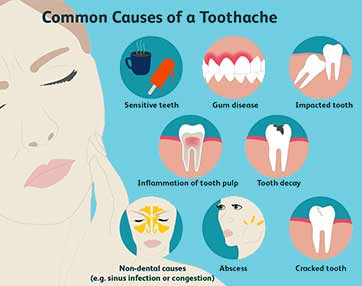
Toothache
Taking Tylenol (acetaminophen) (if you are not allergic) can help alleviate pain. You can apply ice 10-20 minutes every hour for severe pain.
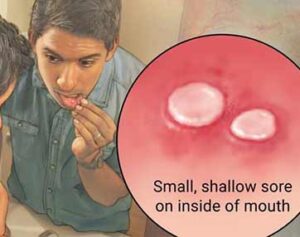
Mouth sore
Applying an over-the-counter medicine, like Orajel or campho-phenique, will pose as a bandage-like film over the sore.
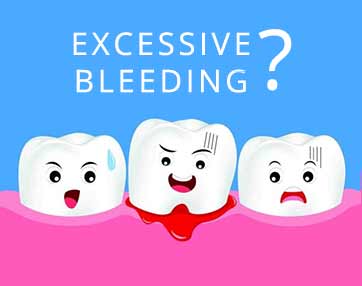
Bleeding after an extraction
If bleeding is substantial, you can place a thick gauze pad over the extraction site, while applying pressure. If bleeding still ensues, you can soak a tea bag in water, put it inside a thin gauze pad, and apply pressure for one full hour.
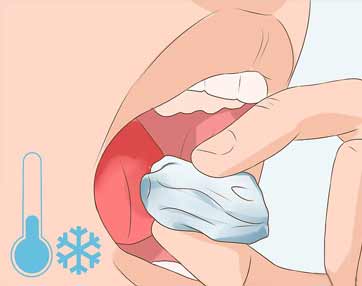
Bitten tongue or lip
Applying ice or pressure to the area will most likely decrease swelling or bleeding. If the laceration is deep (larger than ¼ inch) or if the pain persists, please call our McKinney dentists.

Fractured jaw
Do not move your jaw. Seek immediate medical help at a hospital emergency room.

Tooth knocked out
If you cannot put the tooth back in place and hold it there while rushing to come see us, then you can put it in a cup of milk or water, and come see us immediately.
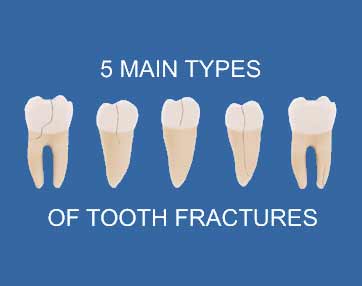
Fractured tooth
Place a piece of soft wax where the chipped area is, and then schedule an appointment with us. Place the pieces of your chipped tooth in a cup of milk, or in water with a pinch of salt.
